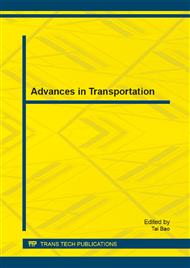p.1153
p.1157
p.1163
p.1167
p.1172
p.1179
p.1183
p.1189
p.1194
A New Floor Field Model for Pedestrian Evacuation Considering Local Density
Abstract:
The behavior of pedestrians around the corner of a room or a corridor is one of the most important features in pedestrian evacuating dynamics. In order to study this in detail, an existing potential field model is modified to capture the pedestrian dynamic around corner by introducing a local density parameter. The local density parameter of a cell is defined as the pedestrian occupancy of the surrounding eight neighbors. Simulations are carried out to study pedestrian evacuation in rooms with corners formed by internal obstacles and walls. The simulation results show that the new model can reproduce the empirical pedestrian dynamics around corner. Pedestrians prefer to walk to lower pedestrian density area although the route may be a little longer. It is also shown that the total evacuation time could be reduced for the evacuation corridor is fully utilized.
Info:
Periodical:
Pages:
1172-1178
Citation:
Online since:
January 2014
Authors:
Keywords:
Price:
Сopyright:
© 2014 Trans Tech Publications Ltd. All Rights Reserved
Share:
Citation:


